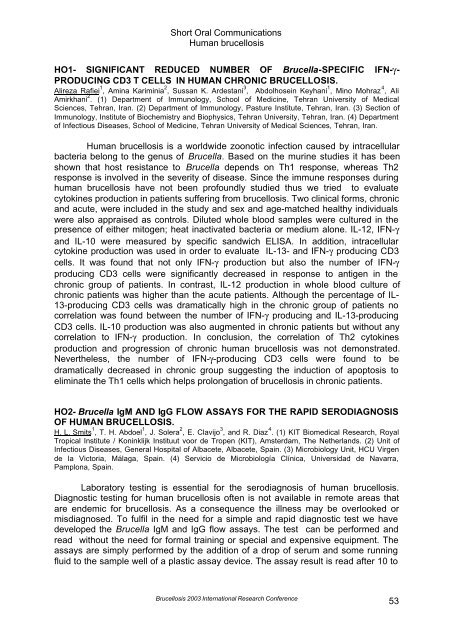Brucellosis 2003 proceedings - PHIDIAS
Brucellosis 2003 proceedings - PHIDIAS
Brucellosis 2003 proceedings - PHIDIAS
Create successful ePaper yourself
Turn your PDF publications into a flip-book with our unique Google optimized e-Paper software.
Short Oral Communications<br />
Human brucellosis<br />
HO1- SIGNIFICANT REDUCED NUMBER OF Brucella-SPECIFIC IFN-g-<br />
PRODUCING CD3 T CELLS IN HUMAN CHRONIC BRUCELLOSIS.<br />
Alireza Rafiei 1 , Amina Kariminia 2 , Sussan K. Ardestani 3 , Abdolhosein Keyhani 1 , Mino Mohraz 4 , Ali<br />
Amirkhani 2 . (1) Department of Immunology, School of Medicine, Tehran University of Medical<br />
Sciences, Tehran, Iran. (2) Department of Immunology, Pasture Institute, Tehran, Iran. (3) Section of<br />
Immunology, Institute of Biochemistry and Biophysics, Tehran University, Tehran, Iran. (4) Department<br />
of Infectious Diseases, School of Medicine, Tehran University of Medical Sciences, Tehran, Iran.<br />
Human brucellosis is a worldwide zoonotic infection caused by intracellular<br />
bacteria belong to the genus of Brucella. Based on the murine studies it has been<br />
shown that host resistance to Brucella depends on Th1 response, whereas Th2<br />
response is involved in the severity of disease. Since the immune responses during<br />
human brucellosis have not been profoundly studied thus we tried to evaluate<br />
cytokines production in patients suffering from brucellosis. Two clinical forms, chronic<br />
and acute, were included in the study and sex and age-matched healthy individuals<br />
were also appraised as controls. Diluted whole blood samples were cultured in the<br />
presence of either mitogen; heat inactivated bacteria or medium alone. IL-12, IFN-γ<br />
and IL-10 were measured by specific sandwich ELISA. In addition, intracellular<br />
cytokine production was used in order to evaluate IL-13- and IFN-γ producing CD3<br />
cells. It was found that not only IFN-γ production but also the number of IFN-γ<br />
producing CD3 cells were significantly decreased in response to antigen in the<br />
chronic group of patients. In contrast, IL-12 production in whole blood culture of<br />
chronic patients was higher than the acute patients. Although the percentage of IL-<br />
13-producing CD3 cells was dramatically high in the chronic group of patients no<br />
correlation was found between the number of IFN-γ producing and IL-13-producing<br />
CD3 cells. IL-10 production was also augmented in chronic patients but without any<br />
correlation to IFN-γ production. In conclusion, the correlation of Th2 cytokines<br />
production and progression of chronic human brucellosis was not demonstrated.<br />
Nevertheless, the number of IFN-γ-producing CD3 cells were found to be<br />
dramatically decreased in chronic group suggesting the induction of apoptosis to<br />
eliminate the Th1 cells which helps prolongation of brucellosis in chronic patients.<br />
HO2- Brucella IgM AND IgG FLOW ASSAYS FOR THE RAPID SERODIAGNOSIS<br />
OF HUMAN BRUCELLOSIS.<br />
H. L. Smits 1 , T. H. Abdoel 1 , J. Solera 2 , E. Clavijo 3 , and R. Diaz 4 . (1) KIT Biomedical Research, Royal<br />
Tropical Institute / Koninklijk Instituut voor de Tropen (KIT), Amsterdam, The Netherlands. (2) Unit of<br />
Infectious Diseases, General Hospital of Albacete, Albacete, Spain. (3) Microbiology Unit, HCU Virgen<br />
de la Victoria, Málaga, Spain. (4) Servicio de Microbiología Clínica, Universidad de Navarra,<br />
Pamplona, Spain.<br />
Laboratory testing is essential for the serodiagnosis of human brucellosis.<br />
Diagnostic testing for human brucellosis often is not available in remote areas that<br />
are endemic for brucellosis. As a consequence the illness may be overlooked or<br />
misdiagnosed. To fulfil in the need for a simple and rapid diagnostic test we have<br />
developed the Brucella IgM and IgG flow assays. The test can be performed and<br />
read without the need for formal training or special and expensive equipment. The<br />
assays are simply performed by the addition of a drop of serum and some running<br />
fluid to the sample well of a plastic assay device. The assay result is read after 10 to<br />
<strong>Brucellosis</strong> <strong>2003</strong> International Research Conference<br />
53
















